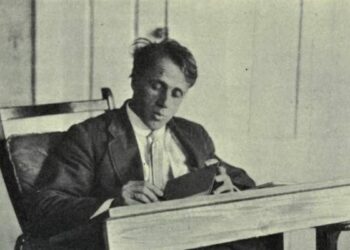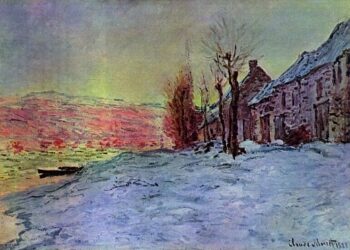Table of Contents
ToggleBrahma Poem Summary line by line
Brahma is a poetic masterpiece written by Ralph Waldo Emerson. This profound work explores the nature of divinity, the interconnectedness of all existence, and the transcendence of human experience by delving into intricate philosophical and spiritual themes. The poem’s meaning is thoroughly explained by breaking down each line in the summary that follows.
Brahma Poem Summary
- If the red slayer think he slays: The poem begins with a thought-provoking statement that questions the idea of a “red slayer” who thinks he is a murderer. This suggests a deeper reality beyond apparent actions, challenging conventional notions of power and agency.
- Or if the slain think he is slain: By taking into account the viewpoint of the one who appears to be defeated, the second line presents a paradox. This calls readers to reconsider their beliefs regarding mortality by hinting at the illusory nature of both life and death.
- They know not well the subtle ways I keep, and pass, and turn again. Emerson presents the nuanced and enigmatic ways that go beyond common comprehension. The speaker suggests that existence is a continuous and cyclical process, and that life’s complex dance is orchestrated by a divine influence.
- Far or forgot to me is near: The poem emphasizes the transcendence of distance and the irrelevance of forgetfulness to the divine. It challenges human perceptions of distance and closeness, indicating a perspective beyond conventional limitations.
- Shadow and sunlight are the same: Here, Emerson blurs the distinction between opposites, asserting the equivalence of shadow and sunlight. This underscores the idea that dualities are unified in a higher reality, transcending ordinary notions of good and evil.
- The vanished gods to me appear; The poet suggests a personal connection to ancient or disappeared deities, implying an awareness that goes beyond historical or cultural boundaries. This aligns with the theme of a transcendent understanding that surpasses conventional limits.
- And one to me are shame and fame. Emerson unifies opposites, declaring shame and fame as one. This challenges societal judgments and underscores the poem’s theme of a higher perspective that sees beyond conventional moral values.
- They reckon ill who leave me out; The poet warns against underestimating or excluding the divine presence. Those who disregard the transcendent perspective are deemed to “reckon ill,” suggesting a failure to comprehend the deeper realities.
- When me they fly, I am the wings; Emerson presents a powerful metaphor, portraying the divine as both the pursued and the means of pursuit. The divine is the wings that enable flight, emphasizing its integral role in both seeking and being sought.
- I am the doubter and the doubt, The speaker identifies with both doubt and the one who questions. This dual role suggests that even skepticism and uncertainty are facets of the divine perspective, reinforcing the poem’s theme of unity in diversity.
- And I the hymn the Brahmin sings. The speaker is the essence of the sacred hymn sung by a Brahmin. This line alludes to Hindu spirituality, aligning the poem with the universal themes found in various religious and philosophical traditions.
- The strong gods pine for my abode, Emerson attributes a longing to powerful deities for a connection with the divine realm he represents. This reverses the conventional idea of humans seeking favor from gods, suggesting a reciprocal relationship.
- And pine in vain the sacred Seven; The “sacred Seven” likely refers to the planetary deities in astrology. Even these revered entities long for the divine presence, emphasizing the overarching influence of the transcendent force.
- But thou, meek lover of the good! The tone shifts to address a humble and virtuous individual. This person, described as a “meek lover of the good,” contrasts with the powerful deities mentioned earlier, highlighting the inclusivity of the divine perspective.
- Find me, and turn thy back on heaven. The speaker urges the humble seeker to find the divine within, suggesting that turning away from conventional notions of heaven is necessary to discover the true source of spiritual insight.
- ‘Burn up thy love: thy own self burn, The poem takes a transformative turn, advising the seeker to burn up their love and, metaphorically, themselves. This suggests a radical purification process, shedding attachments and ego to attain a higher state of being.
- Chanting, with mirthless laughter, still The speaker introduces a paradoxical image of chanting accompanied by “mirthless laughter.” This complex juxtaposition may signify a spiritual journey filled with joy but devoid of conventional amusement.
- The nameless form that all things fill. The poem concludes with a reference to the “nameless form” that permeates all existence. This form transcends specific definitions, pointing to the ineffable and universal nature of the divine.
Also Read-
- She Sweeps with many Colored Brooms Poem Summary line by line
- I Taste A Liquor Never Brewed Poem Summary line by line
Brahma Poem
Conclusion
Brahma by Ralph Waldo Emerson is a deeply philosophical and spiritually charged poem that challenges traditional perspectives on divinity, existence, and the human experience. Emerson employs intricate language, paradoxes, and vivid imagery to convey a transcendent perspective that goes beyond conventional understanding. The poem explores the interconnectedness of all things, the unity of opposites, and the transformative nature of the spiritual journey. It invites readers to question preconceived notions and encourages a profound contemplation of the ineffable and universal aspects of the divine.
FAQs:
1. What is the central theme of “Brahma”?
The central theme of “Brahma” revolves around the transcendence of divinity, challenging conventional views on life, death, and existence. The poem explores the interconnectedness of all things, the unity of opposites, and the transformative journey toward spiritual enlightenment.
2. Why does Emerson use paradoxes in the poem?
Emerson employs paradoxes to convey the complexity of spiritual truths and the limitations of conventional understanding. The juxtaposition of seemingly contradictory ideas encourages readers to transcend logical reasoning and embrace a more profound, intuitive comprehension of the divine.
3. What role does the concept of Brahman play in the poem?
The concept of Brahman, a universal and transcendent reality in Hindu philosophy, serves as a symbolic representation of the divine force that permeates all existence. Emerson uses the term to convey the interconnectedness of the divine with the everyday experiences of individuals.
4. How does the poem challenge traditional religious views?
“Brahma” challenges traditional religious views by presenting a perspective that transcends specific cultural or religious boundaries. Emerson’s portrayal of divinity goes beyond the limitations of organized doctrines, emphasizing a universal and inclusive understanding of the divine.

















